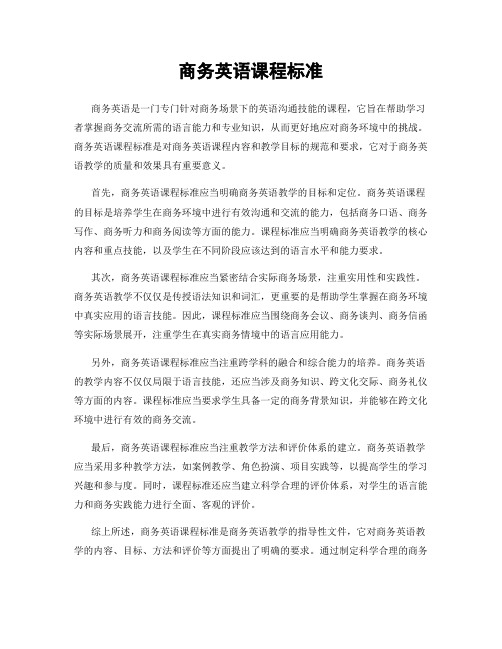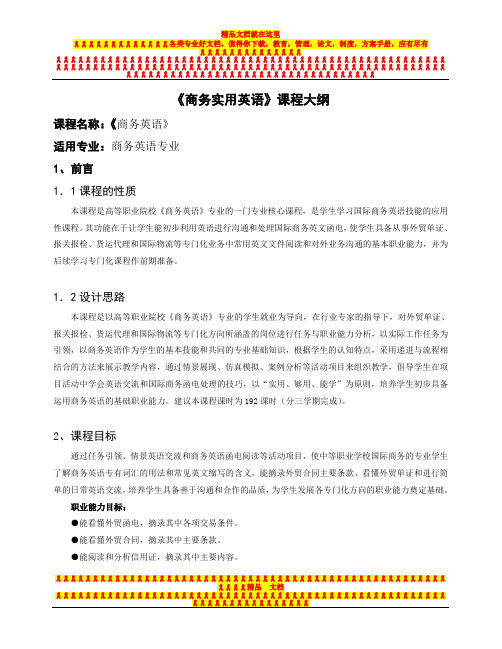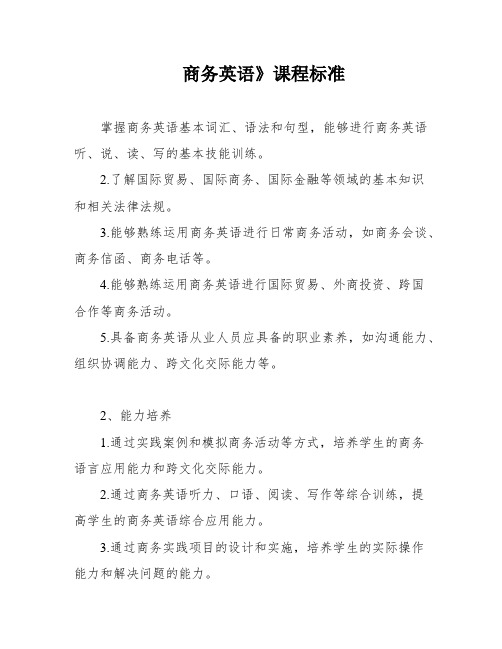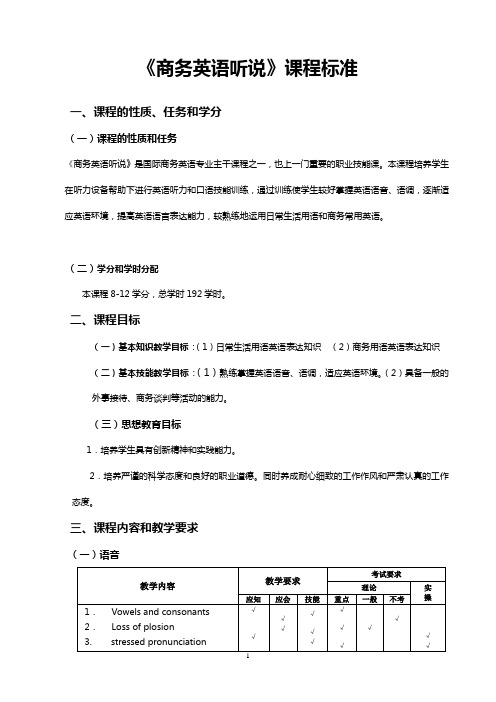《商务英语》课程标准之欧阳光明创编
商务英语课程标准

商务英语课程标准商务英语是一门专门针对商务场景下的英语沟通技能的课程,它旨在帮助学习者掌握商务交流所需的语言能力和专业知识,从而更好地应对商务环境中的挑战。
商务英语课程标准是对商务英语课程内容和教学目标的规范和要求,它对于商务英语教学的质量和效果具有重要意义。
首先,商务英语课程标准应当明确商务英语教学的目标和定位。
商务英语课程的目标是培养学生在商务环境中进行有效沟通和交流的能力,包括商务口语、商务写作、商务听力和商务阅读等方面的能力。
课程标准应当明确商务英语教学的核心内容和重点技能,以及学生在不同阶段应该达到的语言水平和能力要求。
其次,商务英语课程标准应当紧密结合实际商务场景,注重实用性和实践性。
商务英语教学不仅仅是传授语法知识和词汇,更重要的是帮助学生掌握在商务环境中真实应用的语言技能。
因此,课程标准应当围绕商务会议、商务谈判、商务信函等实际场景展开,注重学生在真实商务情境中的语言应用能力。
另外,商务英语课程标准应当注重跨学科的融合和综合能力的培养。
商务英语的教学内容不仅仅局限于语言技能,还应当涉及商务知识、跨文化交际、商务礼仪等方面的内容。
课程标准应当要求学生具备一定的商务背景知识,并能够在跨文化环境中进行有效的商务交流。
最后,商务英语课程标准应当注重教学方法和评价体系的建立。
商务英语教学应当采用多种教学方法,如案例教学、角色扮演、项目实践等,以提高学生的学习兴趣和参与度。
同时,课程标准还应当建立科学合理的评价体系,对学生的语言能力和商务实践能力进行全面、客观的评价。
综上所述,商务英语课程标准是商务英语教学的指导性文件,它对商务英语教学的内容、目标、方法和评价等方面提出了明确的要求。
通过制定科学合理的商务英语课程标准,可以提高商务英语教学的质量和效果,为学生的职业发展和国际交流打下坚实的语言基础。
《商务英语》课程标准

《商务英语》课程标准课程名称:商务英语专业名称:商务英语总课时: 144一、课程定位本课程是中等职业学校商务英语专业的一门专业核心课程。
其功能在于使商务英语专业的学生了解客户接待、会务接待、企业参观、陪同购物、景点参观的基本知识和基本技能,具备从事商务接待、商务沟通等工作的基本英语能力。
它是商务英语听说课程的后续课程。
二、课程设计理念与思路本课程是在商务英语专业工作任务与职业能力分析的基础上,以商业活动中基本英语职业能力为依据而设置。
以工作任务为引领,通过工作任务整合相关知识、技能与态度,将课程设计为任务引领型课程。
课程内容的选取紧紧围绕商务接待、商务沟通等商务工作的基本英语能力的培养。
课程结构以工作环境中的英语基础活动项目为线索设计,包括迎来送往、酒店安排,商务会谈、宴会接待,公司介绍、产品推介,商场购物、售后服务,旅游观光、节日文化介绍5个商务英语基础任务。
本课程建议学时为144学时(含教学活动)。
三、课程目标通过本课程中大量模拟商务情景下的英语实践活动,学生能了解商务英语的性质和特点,能应用英语知识和商务知识进行迎来送往、酒店安排、商务会谈、宴会接待、公司介绍、产品推介、商场购物、售后服务、旅游观光、节日文化介绍等简单的商贸活动所需要的工作,达到上海市基础证书的考证相关要求,具备善于沟通和合作的品质,并达到以下具体职业能力培养目标:1、能从事客户接待方面的基础工作;2、能从事会务接待方面的基础工作;3、能从事企业参观方面的基础工作;4、能从事陪同购物方面的基础工作;5、能从事景点参观方面的基础工作。
四、课程内容选取工作任务技能与学习水平知识与学习水平参考学时景点参观旅游观光●能听懂旅游观光时常用的英语词汇和句型。
●能重复以旅游观光为主题的简单英语短文。
●能完成以旅游观光为主题的简单英汉互译任务1、旅游观光应注意的礼仪知识●知道参观所需的基本礼仪,如:守序、礼让。
2、上海著名景点英语表达●知道外滩、豫园、城隍庙、东方明珠塔等上海著名景点的英语表达。
《国际商务实用英语》课程标准

《商务实用英语》课程大纲课程名称:《商务英语》适用专业:商务英语专业1、前言1.1课程的性质本课程是高等职业院校《商务英语》专业的一门专业核心课程,是学生学习国际商务英语技能的应用性课程。
其功能在于让学生能初步利用英语进行沟通和处理国际商务英文函电,使学生具备从事外贸单证、报关报检、货运代理和国际物流等专门化业务中常用英文文件阅读和对外业务沟通的基本职业能力,并为后续学习专门化课程作前期准备。
1.2设计思路本课程是以高等职业院校《商务英语》专业的学生就业为导向,在行业专家的指导下,对外贸单证、报关报检、货运代理和国际物流等专门化方向所涵盖的岗位进行任务与职业能力分析,以实际工作任务为引领,以商务英语作为学生的基本技能和共同的专业基础知识,根据学生的认知特点,采用递进与流程相结合的方法来展示教学内容,通过情景展现、仿真模拟、案例分析等活动项目来组织教学,倡导学生在项目活动中学会英语交流和国际商务函电处理的技巧,以“实用、够用、能学”为原则,培养学生初步具备运用商务英语的基础职业能力。
建议本课程课时为192课时(分三学期完成)。
2、课程目标通过任务引领、情景英语交流和商务英语函电阅读等活动项目,使中等职业学校国际商务的专业学生了解商务英语专有词汇的用法和常见英文缩写的含义,能摘录外贸合同主要条款、看懂外贸单证和进行简单的日常英语交流,培养学生具备善于沟通和合作的品质,为学生发展各专门化方向的职业能力奠定基础。
职业能力目标:●能看懂外贸函电,摘录其中各项交易条件。
●能看懂外贸合同,摘录其中主要条款。
●能阅读和分析信用证,摘录其中主要内容。
精品 文档●能阅读和理解外贸单证的内容。
●能用英语进行日常商务交流。
3、课程内容和要求精品 文档续表精品 文档4、实施建议4.1教材编写建议4.1.1、必须依据本课程标准编写教材。
4.1.2、教材应充分体现任务引领、实践导向的课程设计思想。
4.1.3、教材以完成任务的典型活动项目来驱动,通过录像、动态流程图、实际案例、情景模拟和课后拓展作业等多种手段,采用递进和流程相结合的方式来组织编写,使学生在各种活动中掌握运用商务英语的基本职业能力。
商务英语课程标准.doc

《商务英语》课程标准一、课程基本情况表二、课程性质本课程为五年制商务英语及国际贸易与实务专业的专业必修课程。
三、课程定位1.本课程在专业课程体系中的地位作用本课程是商务英语专业的必修课程,它是在学生掌握英语听、说、读、写技能的基础上,增加了商务情景下商务英语的运用,为学生学习其它涉外商务专业课程打好英语基础。
2.本课程与职业岗位工作的关系本课程更大程度上体现了学习与职业的挂钩,传统英语已经远不能满足现代职业岗位对于多功能人才的需求,尤其是在对外贸易日益频繁的情况下,因此,商务英语也就应运而生,将语言与专业岗位有机融合,更好的适应了社会的需求。
3.本课程对职业素质养成与职业能力培养的作用本课程是英语语言能力与国际贸易、商务函电等专业课程的有机融合,使学生的职业素质和能力进一步加强,让学生在日后的工作中具有更强的职业竞争优势,更加适应现代社会对复合型专业人才的需求。
4.本课程与前、后课程的关系本课程以基础英语知识和技能为根本依托,要求学习者熟练掌握英语语言及技能运用的基础上,强化商务知识和商务技能的学习和运用,学习者需把商务知识和英语语言的运用融会贯通,同时该课程与其它专业课程也相辅相成,互为基础,对于基础英语和专业课程起着承上启下的作用。
四、课程设计思路1.以就业为导向、能力为本位、职业实践为核心的设计思路本课程本着以学生为中心,充分考虑学生的特点和专业需求,以就业为导向,以“必需,实用,够用”为度,以培养学生的综合能力为本位,以职业实践为核心,以培养高素质的劳动者为目标,以适应当代职业教育和岗位需求的发展与需要。
2.以理论联系实际、知识点与技能点相结合的设计思路本课程应创设仿真商务环境,就所需掌握的知识点与技能点进行典型教学,有针对性的开展教学活动,让学生在实际情境中掌握和运用所需知识,跨越理论与实际间的鸿沟,以到达融会贯通的水平。
3.以案例分析、实证分析为主体的设计思路本课程应安排具体的商务实例,进行情境教学,以案例、实证分析为主线展开教学,引导学生进入实际案例,身临其境的学习课程知识点和技能点,并进一步在实际商务实例运用和巩固所学的知识。
商务英语课程标准

4%
总结性评价:作业
事实和数据
4 过程性评价:情景对话,仿真演练
3%
总结性评价:作业
公司绩效
4 过程性评价:情景对话,仿真演练
4%
总结性评价:作业
考试介绍: 阅读
产品描述
2 小测验
4%
4 过程性评价:情景对话,仿真演练
3%
总结性评价:作业
3
Unit 7b Unit 8a Unit 8b Unit 9 Unit 10a Unit 10b Unit 11a Unit 11b Unit 12 Unit 13a Unit 13b Unit 14a Unit 14b Unit 15 Unit 16a Unit 16b Unit 17a Unit 17b
权重
4%
教学条件
多媒体教室或普通教室
教学活动设计 1、听录音,看视频,模仿语音语调
2、练句型
3、学习教材
4、对话练习
主要考核点 知识
语言点学习与掌握
技能
信息
态度
课堂参与作业
参考资料
《新编剑桥商务英语教程(初级)》教师参考书,Lan Wood, 2007, 第二版,经济科学出版社制作和出版。
UNIT 5 事实和数据,公司绩效
实践
4
权重
4%
教学方法
讲练结合,以练为主
教学条件
多媒体教室或普通教室
教学活动设计 1、听录音,看视频,模仿语音语调
2、练句型
8
3、学习教材
4、对话练习
主要考核点 知识
语言点学习与掌握
技能
描述产品
态度
作业
参考资料
《新编剑桥商务英语教程(初级)》教师参考书,Lan Wood, 2007, 第二版,经济科学出版社制作和出版。
《商务英语综合能力训练》课程标准

心之所向,所向披靡《商务英语综合能力训练》课程标准课程名称:《商务英语综合能力训练》总学时:184学时学分: 11.5适应对象:商务英语专业一、课程的性质与任务(一)课程的定位《商务英语综合能力训练》是商务英语专业必修课,适用于商务英语专业一、二年级的学生。
该课程实用性强,是一门商务知识和英语知识综合运用的课程。
本课程旨在培养和提高国际商务环境中外向型人才的商务英语运用能力。
这门课程遵循“以应用为目的、以实用为主、以够用为度”的教学思想和“在加强语言基础知识和基本技能训练的同时,重视培养学生使用英语进行交际的能力”的目的,将英语语言能力的培养和商务知识学习紧密联系在一起,目的是培养21世纪生产、建设、管理和服务的初、中级第一线专业人才。
通过课程的训练,使学生能够在掌握必不可少的基础理论和专业知识的基础上,更好地掌握和应用国际商务实用英语的操作技能。
(二)《商务英语综合能力训练》课程的前后续课程衔接图(三)课程设计思路1针对毕业生就业岗位要求与企业需求展开调查,所获得的结果作为商务英语学生能力要求的重要标准。
2根据职业岗位要求来确定商务英语的教学目标与教学内容。
课程目标的设定综合考虑能力目标、知识目标与素质目标;课程内容的整合基于工作过程与实际任务;紧紧围绕商务知识这一主线,让学生了解国际商务涵盖的基本范畴,比如国际贸易与经济、工商管理、国际金融、市场营销、国际投资、国际服务、国际经济合作客户服务、产品销售、经营环境、财务管理,以及公司文化等等。
3课程的教学设计以职业活动为导向,以学生为主体,以素质为基础,体现课程的整体化、系统化设计。
先基于外贸群职业岗位要求提出具体任务,体现能力在实践中培养的特点,然后采用情景教学、项目教学、企业现场的教学与训练方法展开项目,教师在学生的做中进行讲解,最大可能地增加了学生的操作主动性,提高学生的实际操作能力,同时邀请企业人员参与部分模块如实习实训过程中的授课;最后以完成课内课外两条线的工作任务为结果,设计考核方案。
商务英语》课程标准

商务英语》课程标准掌握商务英语基本词汇、语法和句型,能够进行商务英语听、说、读、写的基本技能训练。
2.了解国际贸易、国际商务、国际金融等领域的基本知识和相关法律法规。
3.能够熟练运用商务英语进行日常商务活动,如商务会谈、商务信函、商务电话等。
4.能够熟练运用商务英语进行国际贸易、外商投资、跨国合作等商务活动。
5.具备商务英语从业人员应具备的职业素养,如沟通能力、组织协调能力、跨文化交际能力等。
2、能力培养1.通过实践案例和模拟商务活动等方式,培养学生的商务语言应用能力和跨文化交际能力。
2.通过商务英语听力、口语、阅读、写作等综合训练,提高学生的商务英语综合应用能力。
3.通过商务实践项目的设计和实施,培养学生的实际操作能力和解决问题的能力。
3、课程内容1.商务英语基础知识2.商务英语听力与口语训练3.商务英语阅读与写作训练4.商务实践项目设计与实施4、教学方法1.任务驱动型教学方法2.案例分析教学方法3.互动式教学方法4.实践操作教学方法5、考核方式1.平时成绩:包括课堂表现、作业、小组讨论等。
2.期中考试:主要考察学生对商务英语基础知识和技能的掌握情况。
3.期末考试:主要考察学生对商务实践项目的设计和实施情况。
4.实践操作成绩:主要考察学生的实际操作能力和解决问题的能力。
商务英语是商务英语专业的核心课程,旨在培养学生能够适应各类工商企业、外贸部门从事涉外商务工作的能力。
本课程标准采取任务引领型课程体系,强调培养学生的职业能力和实践动手能力。
课程目标包括掌握商务英语基本技能和知识,培养学生的商务语言应用能力和跨文化交际能力,以及实际操作能力和解决问题的能力。
教学方法包括任务驱动型、案例分析、互动式和实践操作。
考核方式包括平时成绩、期中考试、期末考试和实践操作成绩。
总学时为60,学分为3分。
1.听懂直线公司国内销售经理谈论呼叫中心的优势、产品及未来,并研究如何谈论工作实践中的保险及变化。
同时,了解影响行业的变化,进行捕捉具体信息的听力训练。
《商务英语听说》课程标准

《商务英语听说》课程标准一、课程的性质、任务和学分(一)课程的性质和任务《商务英语听说》是国际商务英语专业主干课程之一,也上一门重要的职业技能课。
本课程培养学生在听力设备帮助下进行英语听力和口语技能训练,通过训练使学生较好掌握英语语音、语调,逐渐适应英语环境,提高英语语言表达能力,较熟练地运用日常生活用语和商务常用英语。
(二)学分和学时分配本课程8-12学分,总学时192学时。
二、课程目标(一)基本知识教学目标:(1)日常生活用语英语表达知识(2)商务用语英语表达知识(二)基本技能教学目标:(1)熟练掌握英语语音、语调,适应英语环境。
(2)具备一般的外事接待、商务谈判等活动的能力。
(三)思想教育目标1.培养学生具有创新精神和实践能力。
2.培养严谨的科学态度和良好的职业道德。
同时养成耐心细致的工作作风和严肃认真的工作态度。
三、课程内容和教学要求(一)语音(二)日常交际英语(三)商务交际(四)商务业务(四、课程实施(一)课时安排与教学建议(二)教学组织形式与教学方法要求1.教学组织形式:采用以教学班为单位进行授课的教学形式。
2.教学方法要求:以课堂讲授与学生练习相结合。
3.教学场地要求:语音室五、教材选用1. 《商务英语听说》(规划教材) , 北京交通大学出版社六、课程考核(一)学生考核1.该门学科的考试评价依据是按照课程目标、教学内容和要求,把握合适的难易程度出试卷,用笔试、平时成绩(含作业、出勤)、的方法对学生学习做出评价。
2.考试方法:笔试、实训、平时作业、出勤。
3.期末总成绩(百分制)=平时作业*20%+期末笔试*30%+出勤*20%+实训成绩*30%(二)教师教学效果考核1.由分院组织教研室成员采用随机抽查的手段,检查平时的教学过程(平时作业布置与批改和出勤的登记);2.由分院其他教师出题,对随机抽选所任课程班级的30%的学生进行考核。
3.考核结果评选:》90分的为优秀;》80分的为良;》60分为中合格;〈60分为不合格。
- 1、下载文档前请自行甄别文档内容的完整性,平台不提供额外的编辑、内容补充、找答案等附加服务。
- 2、"仅部分预览"的文档,不可在线预览部分如存在完整性等问题,可反馈申请退款(可完整预览的文档不适用该条件!)。
- 3、如文档侵犯您的权益,请联系客服反馈,我们会尽快为您处理(人工客服工作时间:9:00-18:30)。
商务英语课程标准欧阳光明(2021.03.07)课程名称:商务英语适用专业:高等职业技术学院商务英语专业1、前言1.1 课程的性质《商务英语》是商务英语专业一门重要的核心课程, 是以培养能够适应各类工商企业、外贸部门从事涉外商务工作为目标的应用性课程, 是从事涉外活动经济活动、外事服务必须掌握的专门课程。
作为商务英语专业的学生,不仅必须要掌握一般环境和商务环境下的听、说、读、写基本技能,还要将所学的商务知识和基本技能运用到实际中去,具备从事本专业工作的基本素质和职业能力。
商务英语教学对于学生形成综合的职业能力和创业能力, 以及今后的发展,具有重要的作用。
1.2 设计思路本课程标准的总体设计思路:变三段式课程体系为任务引领型课程体系,打破传统的文化基础课、专业基础课、专业课的三段式课程设置模式,紧紧围绕完成工作任务的需要来选择课程内容;变知识学科本位为职业能力本位,打破传统的以“了解”、“掌握”为特征设定的学科型课程目标,从“任务与职业能力”分析出发,设定职业能力培养目标;变书本知识的传授为动手能力的培养,打破传统的知识传授方式,以“工作项目”为主线,创设工作情景,培养学生的实践动手能力。
本课程标准以建筑工程技术专业学生的就业为导向,根据行业专家对商务英语专业所涵盖的岗位群进行的任务和职业能力分析,同时遵循高等职业学校学生的认知规律,紧密结合职业资格证书中相关考核要求,确定本课程的工作模块和课程内容。
为了充分体现任务引领、实践导向课程思想,本课程按照由简单到复杂的商务工作过程进行贯穿,涉及到了重要商务活动工作过程的各个方面。
该门课程建议总学时为60,学分为3分。
2、课程目标(一)总目标《商务英语》课程的总目标是要求学生通过有针对性地对进行商务英语基本技能训练,提高综合理解和运用商务英语的能力,培养学生灵活用所学的专业知识和基本技能为涉外经济贸易部门、外资企业及政府机构和中外企事业单位的涉外事务提供科学、高效的服务,并为`后续的进一步学习奠定良好的基础,同时具备基本的商务英语从业人员职业素养。
(二)分目标1、知识与能力通过《商务英语》课程学习,掌握相关的商务知识,掌握捕捉相关信息的听力技巧,捕捉相关信息、具体信息的阅读技巧,学习商务文体的特点和商务语篇结构,培养学生的文体意识,掌握常用商务应用文的撰写要求并能写出正确得体的文章,学会结合商务实际用英语进行人际交往和对外开展商务活动,培养学生独立思考和解决问题的能力。
2、过程与方法①通过补充背景信息,拓展相关商务知识,使学生熟悉广泛的商务和跨文化知识,培养从事商务活动的基本能力。
②通过头脑风暴、情景模拟、课堂演示、同桌交流、小组交流、小组合作学习教学等多种手段,使学生开展联想,激发学生积极思考,着重在商务环境指导学生开展语言实践, 培养学生提出问题、分析问题、解决问题的能力。
③养成严谨求实的科学态度以及勤于思考、勇于表达自己的讲解、学会分享、学会合作的学习习惯。
3、情感态度与价值观①充分了解商务英语工作的作用、性质、特点,培养学生严谨求实、开拓创新、热情开朗、随机应变的工作作风和勤勤恳恳的工作态度。
②拓展专业视野,引导学生关注国际商务的发展趋势, 树立终身学习的观念,乐于了解和接受新知识、新技术,愿意与人团结合作的情感。
③培养学生的创新素质和严谨求实的科学态度、精神,强调解放思想,勇于创新。
④在教学过程中,实现上述课程目标是一个不可分割、相互交融、相互渗透的连续过程和有机整体。
在学习的过程中,既有能力的训练,也有方法的了解和运用,更有态度、情感和价值观的体验与培养,着重培养学生使用英语进行人际交往和对外开展商务活动的能力,提升职业素养。
3、课程内容和要求介绍1.1.了解该门课程学习的基本要求;2.2.了解剑桥商务英语证书考试的内容及要求。
第一单元1.了解商会,2.理解名片,并能根据名片识别相关信息;3.询问和介绍工作,说明职务;4.学会提出建议,并能处理员工建议;5.理解合同中的聘用条款,谈论合同的聘用条款;6.学习谈论工作和工作条件;7.进行阅读和听力中捕捉相关信息的训练。
第二单元1.要求学生能读懂大众汽车公司的历史;2.学会询问及描述公司及其历史,谈论公司现状;3. 看懂示图,谈论投资理由;4. 描述公司业务活动;5.进行在阅读捕捉相关信息的训练;第三单元1. 要求学生能识别词汇的词性,根据上下文猜测不熟悉词汇的词义;2. 掌握整理和积累词汇的方法。
第四单元1.练习表达打电话的常用话语;2.学会留言和记录电话留言;3.了解备忘录、便条和通知的文体特点;4.备忘录和电子邮件的写作训练。
5.进行捕捉主要内容和相关具体信息的听力训练第五单元1.阅读和谈论公司的年度报告;2.学会描述柱状图及曲线图,描述市场趋势;3.学习谈论公司业绩;4.进行捕捉主要内容和相关具体信息的听力训练。
第六单元1.了解阅读测试的题型及内容;2.提供建议并进行阅读测试练习。
第七单元1.能听懂产品介绍,识别图片,进一步了解如何描述产品的尺寸、重量,价格等;2.学会描述产品及谈论购买商品时所需考虑的因素;3.学会对各种产品进行一般性描述;4.理解美国药品开发过程的阶段,掌握顺序的表达法;5.学会谈论产品开发的过程,听懂营销经理谈论新上市的计划;6.学会谈论计划;7.进行捕捉具体信息的阅读和听力练习。
第八单元1.对办公室设备进行分类;2.快速阅读办公设备广告,学会填写表格获取有关信息;3.听懂判别办公设备操作故障的谈论;4.了解切纸机使用指南,学会谈论如何操作设备,并会写设备的操作指南;5.谈论商务设备;6.熟悉几种商务信函的格式要求及写作,提高正式商务信函写作的意识;7.在阅读、听力训练过程中捕捉具体信息。
第九单元1.1.了解剑桥商务英语初级考试写作部分的题型及要求;2...提供建议,进行写作测试方面的练习。
第十单元1.了解饭店设施,学习如何谈论为商界人士提供的饭店设施;2.掌握表达如何向人问路或给人指路;3.学习谈论交通和运输的情况;4.进行捕捉具体信息的阅读和听力训练。
第十一单元1.了解会议组织工作涉及的范围;2.阅读有关会议地点的广告并获取信息;3.学会选择会议的地点、检查确认会议安排;4.写确认信;5.谈论安排会议和会议,即日程安排、总结评估等6.进行捕捉具体信息的阅读和听力训练。
第十二单元1.了解剑桥商务英语初级考试写作部分的题型及要求;2.提供建议,进行写作测试方面的练习。
第十三单元1.了解面包生产过程的阶段;2.描述生产程序以及生产工序中出现的一些问题;3.了解快餐食品工厂质量控制经理的工作。
4.学会谈论工作中的质量控制过程,描述质量问题,并能提出提高产品质量的建议;5.进行捕捉具体信息的听力训练第十四单元1.听懂直线公司国内销售经理谈论呼叫中心的事,了解呼叫中心的优势、产品及未来;2.学会谈论工作实践中的保险及变化,利用电话及因特网直接提供服务和推销产品所带来的变化;3.谈论影响行业的变化;4.听懂有关询问家庭银行服务的电话并作记录,填写申请电话银行业务服务;5.学会谈论银行业务及行业内变化;6.进行捕捉具体信息的听力训练。
第十五单元1..熟悉剑桥商务英语初级考试口语部分的题型及要求;2.提供建议进行口试练习。
第十六单元1.了解包裹投递业务的服务,谈论将邮件寄往国外的方法及其利弊;2.交流投递业务的有关信息, 学会计算邮费;3.了解进口代理商的工作内容,学会填写记录;4. 谈论公司定购的商品及其定购方式;5.学习如何谈论贸易活动;6.学会写询价信以及回复询价。
第十七单元1.阅读有关招聘的文章,完成图表,寻找每种招聘方法的优点、缺点;2.学会谈论如何招聘一些岗位的员工;3.阅读求职招聘广告,交流如何招聘员工;4.学习如何谈论招聘员工;4.学会写求职信,谈论谋职及如何参加面试;5.进行捕捉要点和相关信息的阅读和听力训练。
4、实施建议4.1教材编写1、必须依据本课程标准编写教材,教材应充分体现任务引领、实践导向课程的设计思想。
2、教材应将本专业职业活动,分解成若干典型的工作项目,按完成工作项目的需要和岗位操作规程,结合职业技能证书考证组织教材内容。
要通过商务活动过程的各个方面,增加实践实操内容,强调理论与实践的结合。
3、教材应图文并茂,提高学生的学习兴趣,加深学生对商务活动的认识和理解。
教材表达必须精炼、准确、科学。
4、教材内容应体现先进性、通用性、实用性,要将商务活动过程的新思想,新做法及时地纳入教材,使教材更贴近本专业的发展和实际需要。
5、教材中的活动设计的内容要具体,并具有可操作性。
4.2教学方法1、在教学过程中,应立足于加强学生实际操作能力的培养,采用项目教学,以工作任务引领提高学生学习兴趣,激发学生的成就动机。
2、本课程教学的关键是通过典型的活动项目,由教师提出要求或示范,组织学生进行活动,注重“教”与“学”的互动,让学生在活动中增强重合同守信用意识,掌握本课程的职业能力。
3、本课程以注重理论与实际的结合,使学生既掌握商务知识,又掌握听、说、读、写的专业技能,以便很快适应将来职业岗位的需要。
4、在教学过程中,要应用多媒体、投影等教学资源辅助教学,帮助学生直观理解商务活动过程的要点。
5、教学过程中教师应积极引导学生提升职业素养,提高职业道德。
4.3 教学评价建议1、改革传统的学生评价手段和方法,采用阶段评价、目标评价、过程评价,理论与实践一体化评价模式。
2、关注评价的多元性,结合课堂提问、学生作业、平时测验、实验实训、技能竞赛及考试情况,综合评价学生成绩。
3、应注重学生动手能力和实践中分析问题、解决问题能力的考核,对在学习和应用上有创新的学生应予特别鼓励,全面综合评价学生能力。
4.4 课程资源的开发和应用1、注重实验实训指导书和实验实训教材的开发和应用。
2、注重课程资源和现代化教学资源的开发和利用,这些资源有利于创设形象生动的工作情景,激发学生的学习兴趣,促进学生对知识的理解和掌握。
同时,建议加强课程资源的开发,建立多媒体课程资源的数据库,努力实现跨学院多媒体资源的共享,以提高课程资源利用效率。
3、积极开发和利用网络课程资源,充分利用诸如电子书籍、电子期刊、数据库、数字图书馆、教育网站和电子论坛等网上信息资源,使教学从单一媒体向多种媒体转变;教学活动从信息的单向传递向双向交换转变;学生单独学习向合作学习转变。
同时应积极创造条件搭建远程教学平台,扩大课程资源的交互空间。
4、产学合作开发实验实训课程资源,充分利用本行业典型的生产企业的资源,进行产学合作,建立实习实训基地,实践“做中学、学中做、边做边学”的育人理念,满足学生的实习实训,同时为学生的就业创造机会。
5、建立本专业开放实训中心,使之具备现场教学、实验实训、职业技能证书考证的功能,实现教学与实训合一、教学与培训合一、教学与考证合一,满足学生综合职业能力培养的要求。
